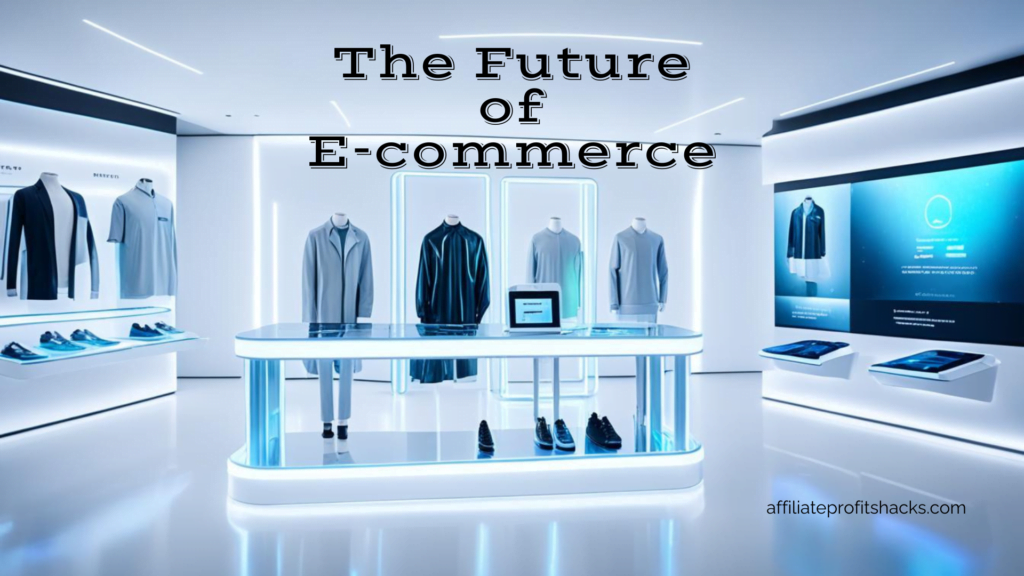The Future of E-commerce: What to Expect in the Next Decade
Welcome to my article about the e-commerce outlook for the next decade!
Imagine a world where you can shop for anything and everything without leaving the comfort of your home. A world where you can browse through a vast selection of products, compare prices, read reviews, and make purchases with just a few taps on your smartphone or clicks on your computer. This is the world of e-commerce, and it has revolutionized the way we shop.
Unlock Instant Access to the Top Way to Earn Money Online – Click HERE!

Over the past decade, e-commerce has experienced unprecedented growth, and there is no sign of it slowing down. With the advancements in technology and the ever-evolving needs of consumers, the future of e-commerce looks incredibly promising.
According to the latest online business forecast and digital commerce projections, the global e-commerce market is projected to reach a staggering $6.35 trillion by 2027. This exponential growth is driven by factors such as convenience, accessibility, and the increasing preference for online shopping. As a result, the e-commerce industry is constantly evolving and adapting to meet the changing needs of consumers.
In this article, we will explore the key trends and predictions that will shape the future of e-commerce in the next decade. From the rise of mobile commerce to the impact of artificial intelligence and machine learning, we will delve into the exciting possibilities that lie ahead. So, get ready to embark on a journey into the future of online shopping.
Key Takeaways:
- E-commerce is projected to reach $6.35 trillion by 2027, signaling significant growth opportunities.
- Mobile commerce will dominate retail e-commerce sales, accounting for 70% by 2024.
- Artificial intelligence and machine learning will revolutionize personalized customer service and product recommendations.
- Social media platforms will become major players in the e-commerce market, shaping the way we research and make purchases.
- Voice search technology will continue to gain popularity, impacting how customers search and shop online.
Mobile Commerce Takes Center Stage
Mobile commerce, also known as m-commerce, is revolutionizing the e-commerce industry. With studies predicting that it will account for 70% of retail e-commerce sales by 2024, businesses need to prioritize mobile-friendly websites to stay competitive in the evolving digital landscape.
In today’s fast-paced world, consumers increasingly rely on their smartphones and tablets to browse and make purchases. The convenience and accessibility of mobile commerce have transformed the way people shop, making it essential for businesses to optimize their online platforms for mobile devices.
Having a mobile-friendly website means more than just resizing the layout to fit smaller screens. It involves creating a seamless user experience that is intuitive and easy to navigate on mobile devices. This includes fast loading times, simple checkout processes, and mobile-responsive designs.
By providing a user-friendly mobile experience, businesses can tap into the growing market of mobile shoppers and increase their e-commerce sales. Furthermore, mobile-friendly websites are not only beneficial for the customers but also for search engine optimization (SEO) purposes. Search engines prioritize mobile-friendly websites in their rankings, boosting visibility and driving organic traffic to the online store.
Why Mobile Commerce Matters in the Retail Industry
The retail industry is undergoing a significant transformation due to the rise of mobile commerce. Consumers now expect seamless shopping experiences on their mobile devices, and businesses must meet these expectations to thrive in the digital marketplace.
“Mobile commerce offers unparalleled convenience and accessibility for consumers. It enables them to shop anytime, anywhere, without the limitations of physical stores. It’s imperative for retailers to embrace this trend and adapt their strategies to cater to mobile-savvy shoppers.”
In addition to meeting customer demands, mobile commerce also presents new opportunities for businesses to engage with their target audience. For example, mobile apps provide a direct channel for personalized promotions, product recommendations, and loyalty programs, enhancing customer satisfaction and driving repeat purchases.
As the retail landscape continues to evolve, businesses must prioritize mobile commerce to remain competitive in the e-commerce market. By investing in mobile-friendly websites and providing a seamless mobile shopping experience, businesses can tap into the growing mobile consumer base and drive their e-commerce sales to new heights.
Artificial Intelligence and Machine Learning Revolutionize E-commerce
Artificial intelligence (AI) and machine learning (ML) are becoming game-changers in the e-commerce industry, transforming the way businesses interact with customers and make data-driven decisions. With the advancements in AI and ML technologies, personalized customer service, customer data analysis, and product recommendations have reached new heights.
One of the key applications of AI in e-commerce is the use of AI-powered chatbots and virtual assistants. These intelligent bots can provide personalized and efficient customer service, handling common queries, and resolving issues in real-time. With their ability to understand natural language, they can engage and assist customers throughout their buying journey, enhancing the overall shopping experience.
Machine learning algorithms play a crucial role in analyzing vast amounts of customer data and extracting valuable insights. By leveraging customer data analysis, businesses can gain a deep understanding of their target audience’s preferences, behavior, and purchase patterns. This knowledge enables them to offer more relevant and personalized product recommendations, increasing the chances of conversions and customer satisfaction.
Moreover, AI and ML empower businesses to optimize pricing strategies and inventory management. By analyzing market trends, competitors’ pricing, and customer demand, e-commerce companies can set competitive prices and avoid overstocking or understocking products. This maximizes profitability and ensures a seamless and efficient supply chain.
“The combination of artificial intelligence and machine learning has revolutionized the way e-commerce companies operate, enabling personalized customer experiences and data-driven decision-making.” – Marcus Anderson, E-commerce Strategist
Unlock Instant Access to the Top Way to Earn Money Online – Click HERE!
As AI and ML continue to evolve, their impact on the e-commerce industry will only grow stronger. With advancements in natural language processing and computer vision, virtual shopping experiences will become more immersive, allowing customers to visualize products and try them virtually before making a purchase.
In conclusion, artificial intelligence and machine learning are redefining the e-commerce landscape, empowering businesses to deliver personalized customer experiences, make data-driven decisions, and optimize operations. As the e-commerce industry continues to expand, embracing AI and ML technologies will be crucial for businesses to stay competitive and meet the evolving needs and expectations of customers.
Social Media as a Sales Channel
Social media platforms like Instagram and Facebook have become major players in the e-commerce market. Businesses are increasingly recognizing the potential of social media as a powerful sales channel. With a wide user base and advanced targeting capabilities, social media platforms offer a unique opportunity to reach and engage with potential customers.
In a recent survey, it was found that 54% of social media users utilize these platforms to research products. The convenience of browsing through product images and reviews on social media makes it a popular choice among consumers. Additionally, 28% of social media users have made direct purchases through these platforms, emphasizing the growing influence of social media on online purchasing.
One of the key advantages of leveraging social media as a sales channel is the ability to build a strong brand presence. By regularly posting engaging content, businesses can establish themselves as trusted and reliable sources of information. This can help in attracting new customers and nurturing existing relationships, leading to increased sales and customer loyalty.
In addition to brand building, social media also allows businesses to directly interact with their target audience. Through comments, direct messages, and live chats, businesses can address customer queries, provide personalized recommendations, and offer exceptional customer service. This direct communication helps in establishing trust and enables businesses to gather valuable feedback and insights to improve their products and services.
Social Commerce: Leveraging the Power of Social Media
“Social commerce is a rapidly growing trend that combines social media and e-commerce, allowing users to discover, research, and purchase products directly through social media platforms. It simplifies the buying process and offers a seamless shopping experience.”
As the e-commerce market continues to evolve, businesses that effectively leverage social media as a sales channel will have a significant advantage. To succeed in social commerce, businesses should focus on creating compelling content, optimizing their social media profiles, and utilizing features like shoppable posts and ads. By integrating social media into their e-commerce strategy, businesses can tap into the massive user base and drive more sales.
The Power of Influencer Marketing
One of the most effective ways to leverage social media for e-commerce is through influencer marketing. Collaborating with influencers who have a significant following and influence in a specific niche can help businesses reach their target audience and drive purchases. By partnering with influencers, businesses can tap into their authenticity, credibility, and expertise to promote their products or services in a more organic and relatable manner.
In conclusion, social media has transformed into a powerful sales channel in the e-commerce market. With its massive user base, advanced targeting capabilities, and opportunities for direct engagement, businesses that embrace social commerce stand to gain a competitive edge. By leveraging social media effectively, businesses can increase brand visibility, drive sales, and foster long-term customer relationships.
Voice Search and its Impact on E-commerce
Voice search technology is revolutionizing the way consumers find products and services online. With the use of voice-activated virtual assistants like Siri, Alexa, and Google Assistant becoming increasingly popular, businesses need to adapt to this emerging trend to stay ahead in the e-commerce industry.
According to industry projections, voice commerce is expected to reach a staggering $19.4 billion by the end of 2023. This significant growth highlights the increasing reliance on voice search as a convenient and efficient method of online shopping. To capitalize on this opportunity, businesses must optimize their websites for voice search.
Optimizing for voice search involves several key factors. Firstly, it’s important to understand that voice search queries tend to be more conversational compared to traditional text-based searches. Therefore, businesses should optimize their content with long-tail keywords and natural language phrases that match how people speak.
“By investing in voice search optimization, businesses can improve their visibility and attract a larger share of the growing voice commerce market.”
Unlock Instant Access to the Top Way to Earn Money Online – Click HERE!
Secondly, businesses need to ensure that their websites are mobile-friendly and responsive, as voice searches are often conducted on mobile devices. In addition, providing concise and accurate answers to common questions in the form of “Frequently Asked Questions” (FAQs) can also increase the chances of appearing in voice search results.
Embracing voice search technology is not only beneficial for improving visibility and driving e-commerce sales, but it also enhances the overall customer experience. By providing voice-activated shopping options, businesses can create a more convenient and effortless online shopping experience for their customers, ultimately leading to higher customer satisfaction and repeat purchases.
To illustrate the impact of voice search on e-commerce, consider this example: a customer using a voice-activated virtual assistant asks, “Where can I find the best smartphones under $500?” If a business has optimized its website for voice search and offers smartphones in that price range, it has a higher chance of appearing in the search results and capturing that customer’s attention.
“The integration of voice search technology in e-commerce provides businesses with an opportunity to engage with customers on a more personal level and cater to their specific needs.”
In conclusion, voice search is transforming the e-commerce landscape. As more consumers turn to voice-activated virtual assistants to search for products and services, businesses must adapt their digital strategies to take advantage of this growing trend. By optimizing websites for voice search, businesses can improve their visibility, attract more customers, and create a seamless and personalized online shopping experience.

Augmented Reality Enhances Shopping Experience
Modern technology has revolutionized the way we shop, and one of the most exciting advancements is augmented reality (AR) technology. AR allows customers to have a more immersive shopping experience by visualizing products in their desired environment before making a purchase. By using AR, customers can get a more profound understanding of how a product will look and fit in their homes, eliminating any doubts or uncertainties.
This immersive shopping experience is made possible through the use of AR technology, which overlays virtual elements in the real world. By using a smartphone or a compatible device, customers can view lifelike representations of products right in front of them, as if they were physically present. This enhances customer satisfaction and reduces returns since customers can now make more informed decisions about their purchases.
“With augmented reality, customers can see how products would look and fit in their homes before making a purchase. This has significantly reduced returns and has led to increased customer satisfaction.”
AR technology has been particularly beneficial for industries where product visualization is essential, such as home decor, furniture, and fashion. Customers can virtually try on clothes, visualize how furniture will look in their living spaces, or even test paint colors on their walls. This saves time and effort and ensures a seamless shopping experience.
In addition, AR technology allows businesses to showcase their products more engagingly and interactively, capturing customer attention and increasing brand loyalty. By using AR experiences in their marketing campaigns, companies can create unique and memorable shopping experiences that leave a lasting impression.
How Augmented Reality Boosts Sales and Customer Engagement
- Improved product visualization: AR allows customers to see how products will look and fit in their environment, reducing any uncertainty and increasing the likelihood of purchase.
- Enhanced customer satisfaction: By providing an immersive shopping experience, customers feel more satisfied with their purchases, leading to positive reviews and repeat business.
- Reduced return rates: With the ability to visualize products accurately, customers make more informed decisions, resulting in fewer returns and exchanges.
- Increased brand loyalty: Businesses that embrace AR technology stand out from the competition, gaining customer loyalty and advocacy.
As AR technology continues to evolve and become more accessible, it has the potential to transform the e-commerce industry. Businesses that incorporate AR into their online shopping experiences can stay ahead of the competition and provide customers with a unique and immersive shopping journey.
Fast and Reliable Delivery Options
In today’s fast-paced world, customer expectations for convenient and efficient service have reached new heights. With the rise of on-demand services like Uber and DoorDash, consumers have become accustomed to receiving products and services quickly. As a result, businesses in the e-commerce industry must adapt and offer fast and reliable delivery options to stay competitive.
One of the key factors driving this demand is the desire for same-day delivery. Customers no longer want to wait days or even weeks for their online purchases to arrive. They expect their orders to be fulfilled and delivered within hours, if not sooner. Businesses that can provide this level of service, offering same-day delivery options, will undoubtedly gain an edge over their competitors.
“Same-day delivery has become an essential aspect of the e-commerce landscape. It enables companies to meet the increasing demands of their customers and stay ahead in a highly competitive market.”
Unlock Instant Access to the Top Way to Earn Money Online – Click HERE!
Furthermore, the emergence of one-hour delivery services has further heightened customer expectations. Companies like Amazon Prime Now and Instacart are setting a new standard by promising to deliver orders within an hour of purchase. This exceptional level of speed and convenience is reshaping customer perceptions of what is possible with online shopping.

Offering fast and reliable delivery options satisfies customer expectations and creates a competitive advantage in the e-commerce industry. The ability to fulfill orders quickly improves customer satisfaction and increases the likelihood of repeat purchases and positive reviews. By prioritizing timely delivery, businesses can build trust and loyalty with their customers.
Meeting the Challenge of On-Demand Services and E-commerce Competition
To meet the challenges posed by on-demand services and the intense competition in the e-commerce market, businesses must invest in infrastructure and logistics. Building a robust delivery network and partnering with reliable shipping providers will ensure efficient order fulfillment and timely delivery.
- Invest in advanced fulfillment technology to streamline order processing and optimize delivery routes.
- Collaborate with third-party logistics providers to leverage their expertise and infrastructure.
- Utilize real-time tracking systems that allow customers to track the progress of their deliveries.
By constantly evolving and improving their delivery capabilities, businesses can exceed customer expectations and remain competitive in an ever-changing industry.
Subscription Services and Long-term Customer Relationships
Subscription services have emerged as a game-changer in the e-commerce market, experiencing tremendous growth of over 100% annually in the past five years. These services offer customers a convenient and predictable way to purchase products, revolutionizing the way businesses build and maintain customer relationships.
By subscribing to a service, customers can enjoy a seamless and hassle-free shopping experience. They no longer need to navigate numerous websites or stores to find what they need. Instead, they can rely on their subscriptions to receive curated products or regular replenishment of essential items.
Convenience is key in today’s fast-paced world, and subscription services meet that need. Customers appreciate the ability to effortlessly shop for their favorite products without the need for repetitive decision-making. This saves time and effort and provides a sense of convenience and peace of mind.
Moreover, subscription services foster customer loyalty by establishing long-term relationships with buyers. When customers subscribe to a particular service, they commit to an ongoing partnership, which can lead to stronger brand loyalty. This loyalty creates a loyal customer base that generates consistent revenue for businesses.
With convenient purchasing at their fingertips, customers are more likely to remain loyal to a business that consistently delivers high-quality products and exceptional service. By meeting customers’ needs through subscription services, businesses can create a sense of exclusivity and foster a community around their brand.
Subscription services are not only about convenience and loyalty but also offer an element of surprise and delight. Customers enjoy the anticipation of receiving their monthly or quarterly subscription box, filled with unique and curated products tailored to their preferences.
The subscription model also allows businesses to gather data and insights about their customer’s preferences and purchasing behavior. This enables personalized product recommendations, improving the overall customer experience and increasing the chances of repeat purchases, further strengthening the long-term customer relationship.
The Power of Subscription Services:
- Convenient and predictable purchasing experience
- Enhanced customer loyalty and retention
- Improved customer satisfaction
- Opportunities for personalized product recommendations
- Data and insights for targeted marketing strategies
Given the growing popularity of subscription services in the e-commerce market, businesses must embrace this trend to stay competitive. By offering subscription options, companies can establish long-term customer relationships, enhance customer loyalty, and secure a steady revenue stream.
Conclusion
The future of e-commerce holds great potential for growth and innovation. By embracing mobile commerce, artificial intelligence, social media, voice search, augmented reality, fast delivery, subscription services, and prioritizing customer personalization and sustainability, you can position your online retail business for success in this rapidly expanding digital market.
Unlock Instant Access to the Top Way to Earn Money Online – Click HERE!
Staying ahead of emerging trends and predictions will play a crucial role in the long-term success of online retailers. As technology continues to evolve, it’s important to adapt and leverage the power of mobile commerce, ensuring your website is optimized for mobile devices and providing a seamless user experience. Utilizing artificial intelligence and machine learning can revolutionize your business by offering personalized customer service and product recommendations based on data analysis.
Don’t underestimate the power of social media as a sales channel. With the increasing number of users researching products and making direct purchases through platforms like Instagram and Facebook, integrating social commerce into your e-commerce strategy can give you a significant advantage. Voice search is also on the rise, so optimizing your website for this feature can help you capture a growing audience of voice shoppers.
Additionally, augmented reality offers a unique opportunity to enhance the shopping experience by allowing customers to visualize products in their own environments, reducing returns and increasing satisfaction. Fast and reliable delivery options, such as same-day or one-hour delivery, are now expected by customers, and subscription services can help build long-term customer relationships and enhance loyalty.
To thrive in the future of e-commerce, online retailers must continually stay informed about the latest trends, predictions, and advancements in the digital market. By leveraging these opportunities and meeting the evolving needs of customers, you can position your business for success in the dynamic world of e-commerce.
Thank you for reading my article “The Future of E-commerce: What to Expect in the Next Decade”. I hope you found it informative and helpful!
For more insights into e-commerce, take a look at this article: E-Commerce Store Ideas: Top 10 Niches for 2024.







